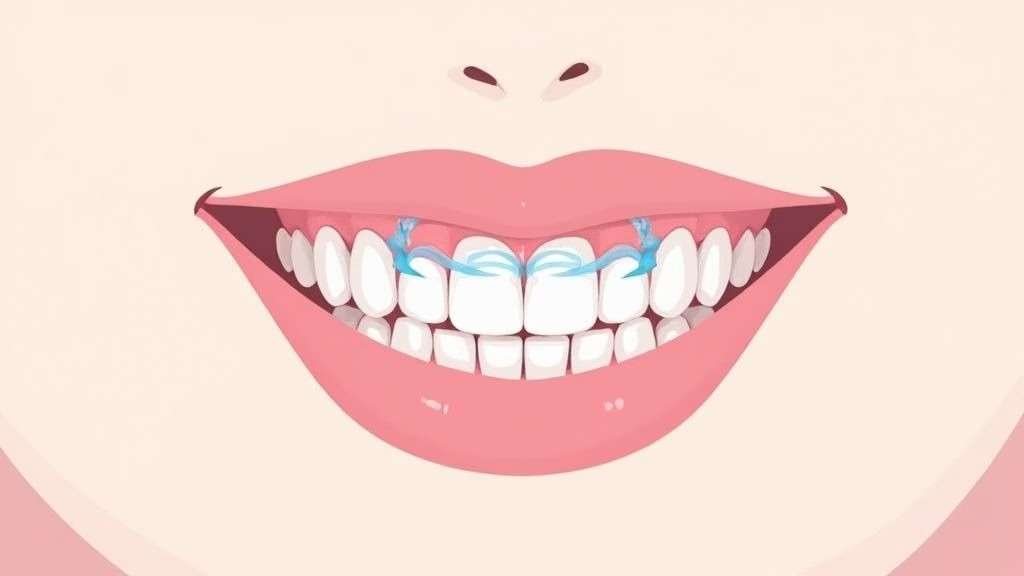Dental Retainer to Straighten Teeth: Expert Guide

Understanding Modern Teeth Straightening Options
Choosing the right teeth straightening option can be a challenge. This guide breaks down everything you need to know about dental retainers – a key tool for achieving and keeping a straighter smile. Learn about the different types, benefits, and how they work as part of orthodontic treatment in the UK.
Types of Dental Retainers Available in the UK
The two main types of retainers used in the UK are Hawley retainers and vacuum-formed retainers (VFRs). Hawley retainers combine acrylic and metal wires to create a strong, adjustable option that can be modified if teeth shift slightly. VFRs use clear, thin plastic that fits snugly over teeth for a more discreet look. The NHS and hospitals most commonly use VFRs, while private practices often recommend Hawley retainers. Read more research on retainer types here.
How Retainers Straighten Teeth
Think of retainers as support structures that maintain the new position of straightened teeth. After teeth are moved using aligners or other methods, retainers hold them in place to prevent shifting back. Just like a garden stake supports a growing plant, retainers provide the steady pressure needed to keep teeth properly aligned over time.
Choosing the Right Retainer for Your Needs
Your ideal retainer depends on your specific situation. Consider factors like:
- How visible do you want the retainer to be
- Whether you need adjustability
- Your budget and lifestyle
- The extent of teeth straightening needed
- Your overall oral health goals
Comparing Retainer Options: Cost and Benefits
Here’s a detailed comparison of the main retainer types to help guide your decision:
| Retainer Type | Material | Durability | Cost Range (£) | Best For |
|---|---|---|---|---|
| Hawley Retainer | Acrylic and metal | High | £150 – £300 | Complex cases, adjustments needed |
| Vacuum-Formed Retainer | Clear plastic | Moderate | £100 – £250 | Simple cases, discreet wear |
For the best results, work with a qualified orthodontist to select the most suitable retainer. They can evaluate your needs and recommend the right option for maintaining your new, confident smile.
Why More Britons Are Choosing Teeth Straightening
The number of people seeking straighter teeth in the UK is growing steadily. More Britons are exploring different options to improve their smiles, marking an important change in dental care priorities. This isn’t just about looks – it reflects both social changes and major advances in orthodontic treatment methods.
The Impact of Technology and Accessibility
One key factor driving this trend is the availability of discreet treatment options. Clear aligners have become a popular choice, offering a less visible alternative to metal braces that appeals particularly to adults. Digital innovations like the Toothfairy app are making orthodontic consultations more accessible, allowing people to start their treatment journey from home. This combination of convenience and discretion has made teeth straightening a more practical option for many.
Shifting Attitudes Towards Dental Aesthetics
A well-aligned smile has become increasingly important in both personal and professional settings. More than 75% of orthodontists report seeing more adult patients seeking treatment, according to the British Orthodontic Society. People are more aware that misaligned teeth can affect:
- Speech clarity
- Chewing ability
- Self-confidence
- Overall facial appearance
Workplace Influences and the Rise of Video Conferencing
The surge in video calls and online meetings has made people more conscious of their smile. Seeing themselves on screen regularly has motivated many to improve their dental appearance. The rise in remote work has coincided with easier access to orthodontic information and treatment options. This combination has encouraged more Britons to take action on achieving straighter teeth while prioritizing their oral health.
Smart Investment in Your Smile

Getting your teeth straightened with a dental retainer is an important choice that affects both your dental health and your wallet. Making the right decision requires understanding the different costs of teeth straightening options available in the UK.
NHS vs. Private Treatment: Understanding the Costs
For children under 18, NHS treatment may cover the full cost of orthodontic work including retainers, but eligibility depends on the Index of Orthodontic Treatment Need (IOTN). Only those with significant orthodontic issues qualify.
Adults and those not eligible for NHS care can choose private treatment, which offers more options and shorter wait times. Private care provides various aligners and retainers to match individual preferences, though costs vary based on your specific case.
Breaking Down Private Treatment Costs in the UK
Private teeth straightening with dental retainers typically costs between £1,000 to £5,000 in the UK. Complex cases requiring extensive adjustments cost more. Location and orthodontist experience also affect pricing. Recent market data shows UK orthodontics declined from USD 148.7 million in 2019 to USD 113.5 million in 2020 during COVID-19. Find more details here.
Payment Options and Financing Solutions
Most private practices offer flexible payment plans:
- Pay-as-you-go: Split costs over your treatment period
- Upfront payment: Get a discount for paying the full amount initially
- Finance plans: Break down costs into monthly payments
Talk to your orthodontist about which payment option works best for your budget.
Hidden Costs to Watch For
Beyond the main treatment cost, be aware of potential extra expenses:
- Consultation fees: Most initial orthodontist visits have a charge
- Retainer replacements: Lost or damaged retainers need replacing
- Refinement treatments: Additional adjustments may be needed later
Having an upfront discussion about all possible costs helps you plan effectively and avoid surprises. Understanding the full range of expenses and payment choices lets you make a smart choice about investing in your smile.
Maximizing Your Retainer’s Effectiveness

A dental retainer plays a key role in preserving your newly straightened smile. Taking proper care ensures your investment continues paying off for years to come. The key is knowing the right cleaning methods, storage practices, and maintenance techniques.
Essential Cleaning Techniques for Your Retainer
Clean your retainer regularly, just like your teeth, to prevent bacteria buildup and odors. For both Hawley and vacuum-formed retainers, use a soft toothbrush with mild toothpaste for gentle but thorough cleaning.
- Avoid using hot water which can damage and warp the retainer material
- Soak retainers in denture cleaner or a mix of cool water and baking soda to remove buildup
- Rinse thoroughly after cleaning to wash away any residue
Safe Storage Practices
Protect your retainer by always storing it properly in its case when not being worn. This simple habit prevents damage and helps maintain its shape.
- Never wrap retainers in tissues or napkins – they often get thrown away by mistake
- Keep storage cases clean and dry to stop bacteria growth
- Avoid direct sunlight and extreme temperatures that can warp the material
Maintaining Your Retainer’s Shape and Effectiveness
Preventing retainer warping helps ensure it keeps working effectively. Studies show that 25% of patients don’t wear retainers as directed, which can lead to teeth shifting back. Find more details here.
- Handle retainers carefully without bending or twisting
- Follow your orthodontist’s guidance on wear time
- Schedule regular dental check-ups to catch any issues early
Incorporating Retainer Wear Into Your Daily Routine
While wearing a retainer may feel strange at first, it quickly becomes a normal part of your daily habits. Set up a consistent cleaning schedule and keep your case somewhere visible as a reminder. Consider getting a travel case for on-the-go convenience. Following these basic guidelines helps protect your investment in straight teeth for the long term.
Expert Answers to Your Retainer Questions
Navigating dental retainer treatment comes with many questions. Here’s your guide to comfort, adaptation, wearing schedules and social considerations as you work toward straighter teeth in the UK.
Comfort and Adaptation
Will my retainer be uncomfortable? Like breaking in new shoes, retainers can feel strange at first. You may notice some pressure or tightness as your teeth adjust to their new position. Most patients find this mild sensation fades within a few days.
What can I do to manage initial discomfort? Simple solutions like taking over-the-counter pain relievers (ibuprofen or paracetamol) and rinsing with warm salt water can help soothe any soreness. Your orthodontist can provide additional tips specific to your situation.
Speech and Eating
Will my retainer affect my speech? Some types, particularly Hawley retainers with front wires, may cause a temporary lisp or changes in pronunciation. Most patients adjust within 1-2 weeks through regular speaking practice. Reading aloud can speed up adaptation.
Can I eat with my retainer? Remove removable retainers before eating to prevent damage and trapped food. Fixed retainers require some eating adjustments – your orthodontist will explain proper care and maintenance for your specific type.
Wearing Schedule and Treatment Time
How long will I need to wear my retainer? Treatment length varies by individual case complexity. Some patients need just a few months of retainer wear, while others require long-term use to maintain results. Your orthodontist will create a personalized plan.
Below is a typical progression of retainer wear schedules:
| Treatment Stage | Daily Wear Time | Duration | Key Notes |
|---|---|---|---|
| Initial Phase (after active treatment) | 22-24 hours | 3-6 months | Essential for stabilising teeth in their new position |
| Transition Phase | 14-16 hours (often overnight) | Several months or indefinitely | Gradual reduction in wear time |
| Long-Term Maintenance | As advised by an orthodontist | Varies | May involve nighttime wear or less frequent use |
Social Situations and Appearance
Will my retainer be noticeable? Modern retainers prioritize discretion. Vacuum-formed retainers are nearly invisible, while even traditional Hawley retainers offer customizable, low-profile options. Discuss appearance concerns with your orthodontist to find the most discreet solution.
How do I clean my retainer in public? Keep a small case and cleaning solution handy. Excuse yourself briefly to rinse in private when needed. Removable retainers make this process simpler.
Recognising Signs of Adjustment Need
How do I know if my retainer needs adjusting? Schedule regular checkups to monitor fit. Contact your orthodontist if you notice:
- Pain or significant discomfort
- Difficulty inserting or removing the retainer
- Visible shifting of teeth
- Retainer feels too loose or tight
Understanding these key aspects helps ensure successful treatment. Always consult your orthodontist for guidance tailored to your specific needs and goals for achieving your ideal smile.
Your Path to a Confident Smile
Getting started with teeth straightening can feel overwhelming. This guide will help you make informed decisions about your treatment, ask the right questions, and find the best path forward. By understanding your options and working closely with dental professionals, you can achieve the smile you’ve always wanted.
Essential Questions for Your Orthodontist
When meeting with your orthodontist, asking good questions helps ensure you get the care you need. Here are key topics to discuss:
- What retainer types would work best for my specific case?
- What are the advantages and drawbacks of different retainer options?
- How long will treatment take with a retainer?
- What are all the costs involved, including future maintenance?
- What’s the long-term plan after initial treatment ends?
- Can you share examples of similar cases you’ve treated successfully?
Evaluating Treatment Options: A Practical Checklist
Consider these important factors when comparing treatments:
- Results: How effectively will it fix my alignment issues?
- Comfort Level: What should I expect in terms of adjustment and wear?
- Appearance: How noticeable will the retainer be?
- Daily Care: What cleaning and maintenance is needed?
- Financial Impact: What are the total costs and payment options?
- Daily Life: How will it affect eating, speaking and other activities?
Choosing the Right Retainer Solution: Expert Criteria
Work with your orthodontist to select the best retainer based on:
- Alignment Needs: Minor issues may only need a simple vacuum-formed retainer, while complex cases could require an adjustable Hawley retainer
- Oral Health Habits: Be honest about your dental care routine, as some retainers need more thorough cleaning
- Time Commitment: Understand how long you’ll need to wear the retainer
- Cost Considerations: Review prices for different options to find one that fits your budget
Real Success Stories and Practical Tips
Learning from others who have successfully straightened their teeth with retainers can provide helpful insights and encouragement. Many patients achieve excellent results when following their treatment plan consistently. Your orthodontist can share relevant case examples and personalized advice for incorporating retainer wear into your daily routine.
Remember that improving your smile takes time and dedication. With proper guidance from your orthodontist and commitment to your treatment plan, you can achieve lasting results and feel more confident about your smile.
Start your smile transformation today with the Toothfairy app. Book your free consultation now!
Last updated on March 5, 2025

Dr. Deepak
ToothFairy Care Team.
Dr. Deepak
ToothFairy Care Team.





